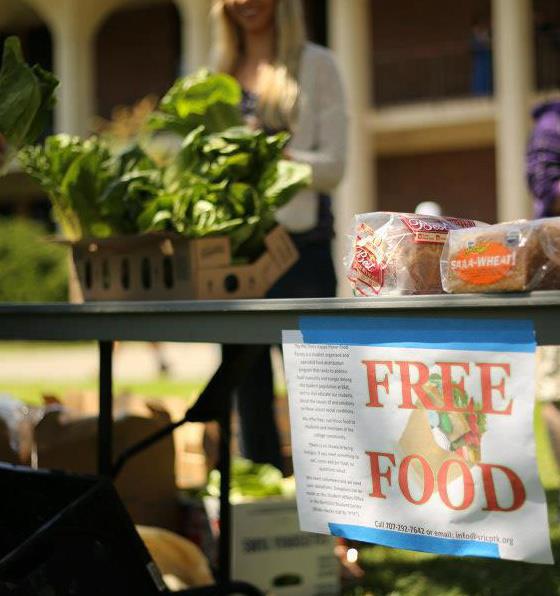We all have heard about the importance of having full bellies so that children can learn. I have heard it over and over as rationale for having free lunch as well as serving free breakfast at schools, sometimes it is the only meal a child will have that day. Hunger is a real issue in this country, and so is hunger on college campuses.
Last fall, the Wisconsin HOPE Lab fielded a groundbreaking survey at 70 community colleges around the country in order to assess rates of food and housing insecurity among community college students. The researchers produced a report, Hungry and Homeless in College, that revealed that one in three community college students have experienced hunger, half of community college students were housing insecure, and 13 to 14% were homeless. That study built on several prior studies they conducted with community college students and students at public, four-year colleges, including Hungry to Learn, a study discussed in the New York Times piece titled “Hungry, Homeless and in College.”
We in Sonoma County, the local community college and CSU campus, are not immune to the college student hunger issue. In fall of 2016, the local CSU student newspaper wrote on this particular topic, sharing that a CSU chancellor commissioned study that found 21 percent of students on their campuses to be food insecure, adding that “A Feeding America study [found] that one in 10 food-deprived U.S. adults were students in 2013.” At the local community college in 2013, about 4% (nearly 800 students) of students pursuing a degree were either homeless, couch surfing, or living in a shelter. Some of these students are former foster youth as well as the first to in their families to attend college or pursue a higher education. While the community college serves predominately local students, or community members, in this county, that is an overwhelming large number.
Sonoma County is divided into 40 school districts for kindergarten through twelfth-grade (K-12) educational services. There are 31 elementary, three high school, and six unified districts. Enrolling over 71,000 just in K – 12th grades, about 40% of the 4,500 graduates of 2016 were enrolled at the local community college, this is just within the county. The Santa Rosa Community College (SRJC) is a great college and sees student from all over the north bay and even internationally. Therefore, the issue of homelessness and food insecurity is alarming. The local community college passed a resolution to support opening the athletics showers early in the morning even when classes were not in session to provide students with housing challenges an opportunity to shower. It also began distributing food on campus every week, thanks to an on-campus organization whose mission is to assist those experiencing food insecurity. This fall semester SRJC opened a food pantry, something that is sadly not uncommon on college campuses anymore.
In the state, Assembly member Monique Limón (D-Santa Barbara) introduced AB 453, that aims to reduce hunger among low-income Californians who are attending college by establishing a “Food Insecure-Free Campus” designation. The goal is to encourage and incentivize anti-hunger efforts on California’s public institutions of higher education having “college campuses pursue on-campus anti-hunger efforts by establishing a “Hunger Free Campus.” This would be done by establishing a Swipe Out Hunger program, an on-campus pantry or partner with a local food bank to provide regular on-campus food distributions and/or designate a person on campus to make sure that the students on campus have access to accurate information about CalFresh and how to apply.” As of June 2017, the bill has been referred to the committee on education.
When we think of our first generation and underrepresented students that go on to pursue a higher education, we should not see this as a luxury or a privilege because in these times a college degree is essential to move up the social ladder, especially for Latinos who are the largest minority group in California. Our young Latino students today face great economic setbacks that include food and housing insecurity. As cost for everything goes up including tuition, minimum wage as well as financial aid has not. Therefore, keep an eye out for college students, the meal you offer them might be the only one they have for the day.
Mariana Martinez
Latest posts by Mariana Martinez (see all)
- Conozca a Omar Medina, Candidato a Miembro de la Junta Escolar de la Ciudad de Santa Rosa para el Área 4 - October 2, 2018
- Meet Omar Medina, Candidate for Santa Rosa City School Board Trustee for Area 4 - September 26, 2018
- Perfil de Luchadora: Conozca a Ariana Aparicio, Estudiante DACA y Dirigida a Harvard - August 28, 2018
- Luchadora Profile: Meet Ariana Aparacio, DACAmented and Headed to Harvard - August 24, 2018
- La Estudiante de Sonoma State Patricia Ayala Macías, Comparte Por Qué es Importante Que Los Estudiantes Universitarios Participen en el Gobierno Estudiantil - April 6, 2018

